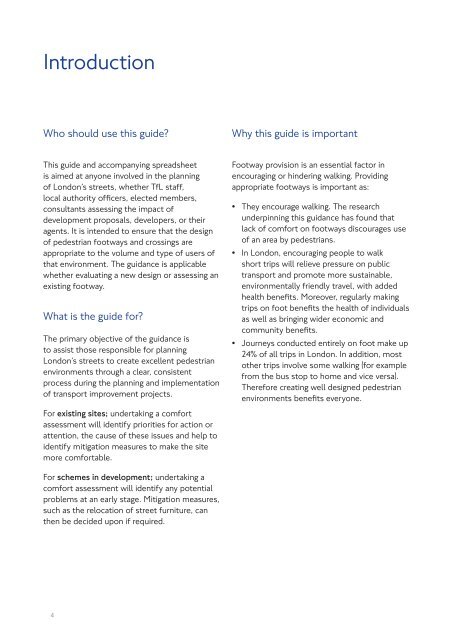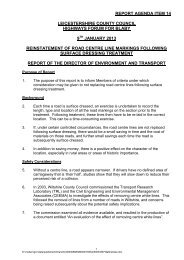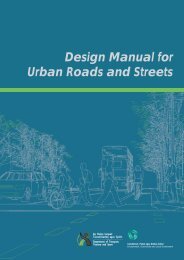Pedestrian Comfort Guidance for London
Pedestrian Comfort Guidance for London
Pedestrian Comfort Guidance for London
You also want an ePaper? Increase the reach of your titles
YUMPU automatically turns print PDFs into web optimized ePapers that Google loves.
Introduction<br />
Who should use this guide? Why this guide is important<br />
This guide and accompanying spreadsheet<br />
is aimed at anyone involved in the planning<br />
of <strong>London</strong>’s streets, whether TfL staff,<br />
local authority officers, elected members,<br />
consultants assessing the impact of<br />
development proposals, developers, or their<br />
agents. It is intended to ensure that the design<br />
of pedestrian footways and crossings are<br />
appropriate to the volume and type of users of<br />
that environment. The guidance is applicable<br />
whether evaluating a new design or assessing an<br />
existing footway.<br />
What is the guide <strong>for</strong>?<br />
The primary objective of the guidance is<br />
to assist those responsible <strong>for</strong> planning<br />
<strong>London</strong>’s streets to create excellent pedestrian<br />
environments through a clear, consistent<br />
process during the planning and implementation<br />
of transport improvement projects.<br />
For existing sites; undertaking a com<strong>for</strong>t<br />
assessment will identify priorities <strong>for</strong> action or<br />
attention, the cause of these issues and help to<br />
identify mitigation measures to make the site<br />
more com<strong>for</strong>table.<br />
For schemes in development; undertaking a<br />
com<strong>for</strong>t assessment will identify any potential<br />
problems at an early stage. Mitigation measures,<br />
such as the relocation of street furniture, can<br />
then be decided upon if required.<br />
4<br />
Footway provision is an essential factor in<br />
encouraging or hindering walking. Providing<br />
appropriate footways is important as:<br />
•<br />
•<br />
•<br />
They encourage walking. The research<br />
underpinning this guidance has found that<br />
lack of com<strong>for</strong>t on footways discourages use<br />
of an area by pedestrians.<br />
In <strong>London</strong>, encouraging people to walk<br />
short trips will relieve pressure on public<br />
transport and promote more sustainable,<br />
environmentally friendly travel, with added<br />
health benefits. Moreover, regularly making<br />
trips on foot benefits the health of individuals<br />
as well as bringing wider economic and<br />
community benefits.<br />
Journeys conducted entirely on foot make up<br />
24% of all trips in <strong>London</strong>. In addition, most<br />
other trips involve some walking (<strong>for</strong> example<br />
from the bus stop to home and vice versa).<br />
There<strong>for</strong>e creating well designed pedestrian<br />
environments benefits everyone.




